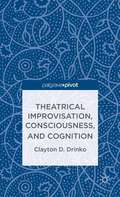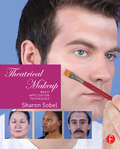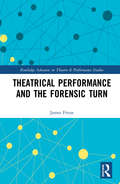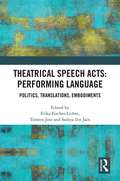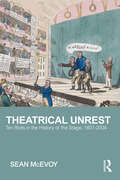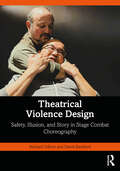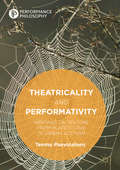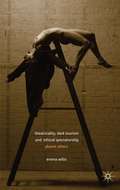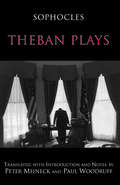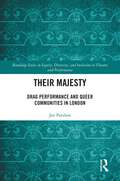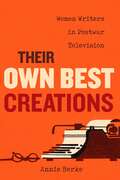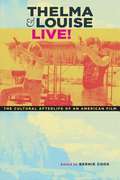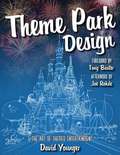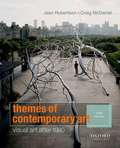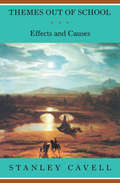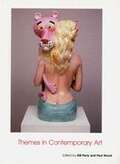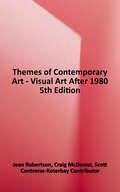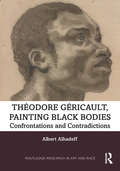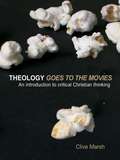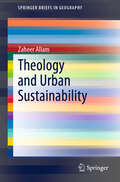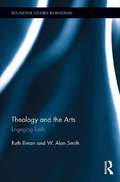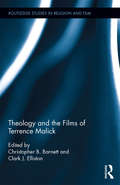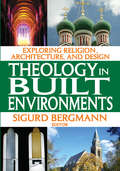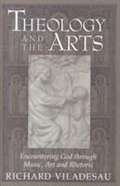- Table View
- List View
Theatrical Improvisation, Consciousness, and Cognition
by Clayton D. DrinkoImprovisation teachers have long known that the human mind could be trained to be effortlessly spontaneous and intuitive. Drinko explores what these improvisation teachers knew about improvisation's effects on consciousness and cognition and compares these theories to current findings in cognitive neuroscience, psychology, and philosophy.
Theatrical Makeup: Basic Application Techniques
by Sharon SobelIn many theatrical productions, it falls to the performers to apply their own makeup, with minimal or no instruction. Theatrical Makeup clearly and concisely explains the basics of theatrical makeup techniques to allow stage actors to put their best face forward! You will gain understanding of the physiology of the human face and, using cream based makeup, as well as commercial cosmetics, learn how to contour it to suit your character with the use of highlight and shadow. Hundreds of full color images and step-by-step instructions illustrate how to visually manipulate bone structure and apparent age, apply simple facial hair and wounds, and create glamorous and natural stage makeup. Also covered are the tools you will need to apply your own makeup, along with critical health and hygiene tips.
Theatrical Makeup: Basic Application Techniques
by Sharon SobelTheatrical Makeup clearly and concisely explains the basics of theatrical makeup techniques to allow stage actors to put their best face forward! Readers will gain understanding of the physiology of the human face and, using cream based makeup, as well as commercial cosmetics, learn how to contour it to suit the character with the use of highlight and shadow. Hundreds of full color images and step-by-step instructions illustrate how to visually manipulate bone structure and apparent age, apply simple facial hair and wounds, and create glamorous and natural stage makeup. Also covered are the tools readers will need to apply their own makeup, along with critical health and hygiene tips. This book is suitable for beginner Theatrical Makeup courses and for stage actors of all levels.
Theatrical Performance and the Forensic Turn: Naked Truth (Routledge Advances in Theatre & Performance Studies)
by James FriezeContemporary theatre, like so much of contemporary life, is obsessed with the ways of which information is detected, packaged and circulated. Running through forms as diverse as neo-naturalistic playwriting, intimately immersive theatre, verbatim drama, intermedial performance, and musical theatre, a common thread can be observed: theatre-makers have moved away from assertions of what is true and focussed on questions about how truth is framed. Commentators in various disciplines, including education, fine art, journalism, medicine, cultural studies, and law, have identified a ‘forensic turn’ in culture. The crucial role played by theatrical and performative techniques in fuelling this forensic turn has frequently been mentioned but never examined in detail. Political and poetic, Theatrical Performance and the Forensic Turn is the first account of the relationship between theatrical and forensic aesthetics. Exploring a rich variety of works that interrogate and resist the forensic turn, this is a must-read not only for scholars of theatre and performance but also of culture across the arts, sciences and social sciences.
Theatrical Speech Acts: Politics, Translations, Embodiments
by Erika Fischer-Lichte Torsten Jost Saskya Iris JainTheatrical Speech Acts: Performing Language explores the significance and impact of words in performance, probing how language functions in theatrical scenarios, what it can achieve under particular conditions, and what kinds of problems may arise as a result. Presenting case studies from around the globe—spanning Argentina, Egypt, Germany, India, Indonesia, Korea, Kenya, Nigeria, Rwanda, Thailand, the UK and the US—the authors explore key issues related to theatrical speech acts, such as (post)colonial language politics; histories, practices and theories of translation for/in performance; as well as practices and processes of embodiment. With scholars from different cultural and disciplinary backgrounds examining theatrical speech acts—their preconditions, their cultural and bodily dimensions as well as their manifold political effects—the book introduces readers to a crucial linguistic dimension of historical and contemporary processes of interweaving performance cultures. Ideal for drama, theater, performance, and translation scholars worldwide, Theatrical Speech Acts opens up a unique perspective on the transformative power of language in performance.
Theatrical Unrest: Ten Riots in the History of the Stage, 1601-2004
by Sean McEvoyShortlisted for the 2017 Theatre Book Prize What is it about theatre, compared to other kinds of cultural representation, which provokes such a powerful reaction? Theatrical Unrest tells the compelling tales of ten riots whose cause lies on stage. It looks at the intensity and evanescence of the live event and asks whether theatre shares its unrepeatable quality with history. Tracing episodes of unrest in theatrical history from an Elizabethan uprising over Shakespeare's Richard II to Sikhs in revolt at Gurpreet Kaur Bhatti's Behzti, Sean McEvoy chronicles a selection of extreme public responses to this inflammatory art form. Each chapter provides a useful overview of the structure and documentation of one particular event, juxtaposing eyewitness accounts with newspaper reports and other contemporary narratives. Theatrical Unrest is an absorbing account of the explosive impact of performance, and an essential read for anyone interested in theatre’s often violent history.
Theatrical Violence Design: Safety, Illusion, and Story in Stage Combat Choreography
by Richard Gilbert David BarefordTheatrical Violence Design offers the reader a complete education in the theory and practice of designing violence for the theater. From swordfights to exchanges of gunfire to domestic violence, the theater abounds in physical conflict. The artists who design that violence, sometimes called fight directors or choreographers, will find in this book an invaluable resource for becoming more expert at their craft. In the chapters of this book, they will encounter the core principles of creating violent effects, the body of knowledge with which they should be familiar, and the nuts and bolts of the process of design work from the first meeting with a director through closing night.This book is written for the student of stage combat to transition into violence design and will also be of interest to experienced violence designers and choreographers.
Theatricality and Performativity: Writings On Texture From Plato's Cave To Urban Activism (Performance Philosophy)
by Teemu PaavolainenThis book defines theatricality and performativity through metaphors of texture and weaving, drawn mainly from anthropologist Tim Ingold and philosopher Stephen C. Pepper. Tracing the two concepts’ various relations to practices of seeing and doing, but also to conflicting values of novelty and normativity, the study proceeds in a series of intertwining threads, from the theatrical to the performative: Antitheatrical (Plato, the Baroque, Michael Fried); Pro-theatrical (directors Wagner, Fuchs, Meyerhold, Brecht, and Brook); Dramatic (weaving memory in Shaffer’s Amadeus and Beckett’s Footfalls); Efficient (from modernist “machines for living in” to the “smart home”); Activist (knit graffiti, clown patrols, and the Anthropo(s)cene). An approach is developed in which ‘performativity’ names the way we tacitly weave worlds and identities, variously concealed or clarified by the step-aside tactics of ‘theatricality’.
Theatricality, Dark Tourism and Ethical Spectatorship
by Emma WillisTheatricality, Dark Tourism and Ethical Spectatorship: Absent Others builds upon recent literature concerning theatre and ethics and offers a uniquely interdisciplinary approach. With a focus on spectatorship, the book brings together analysis of dark tourism – travel to sites of death and disaster – and theatrical performances. At dark tourism sites, objects and architecture are often personified, imagined to speak on behalf of absent victims. Spectatorsare drawn into this dialogical scenario in that they are asked to 'hear' the voices of the dead. Theatrical performances that depict grievous histories often gain power through paradoxically demonstrating the limits of their representational ability: spectators are asked to attune themselves to absences and incomprehensibilities. This study asks whether playing the part of the listener can be understood in ethical terms. Sites surveyed span a broad geographical scope – Germany, Poland, Vietnam, Cambodia, New Zealand and Rwanda – and are brought into contrast with performances including: Jerzy Grotowski's Akropolis, Catherine Filloux's Photographs from S21, Adrienne Kennedy's An Evening with Dead Essex and Erik Ehn's Maria Kizito.
Theban Plays
by Sophocles Paul Woodruff Peter MeineckThis volume offers the fruits of Peter Meineck and Paul Woodruff's dynamic collaboration on the plays of Sophocles' Theban cycle, presenting the translators' Oedipus Tyrannus (2000) along with Woodruff's Antigone (2001) and a muscular new Oedipus at Colonus by Meineck. Grippingly readable, all three translations combine fidelity to the Greek with concision, clarity, and powerful, hard-edged speech. Each play features foot-of-the-page notes, stage directions, and line numbers to the Greek. Woodruff's Introduction discusses the playwright, Athenian theatre and performance, the composition of the plays, and the plots and characters of each; it also offers thoughtful reflections on major critical interpretations of these plays.
Their Majesty: Drag Performance and Queer Communities in London (Routledge Series in Equity, Diversity, and Inclusion in Theatre and Performance)
by Joe ParslowThis book explores drag performance in London since 2009 via the pubs, bars and clubs that make LGBTQ+ communities thrive.It studies the complex relationship between drag performance, LGBTQ+ venues and queer communities. In exploring drag performance, the book develops a greater understanding of the connection between drag performance and queer communities, in particular exploring how drag might facilitate queer communities and offer queer modes of survival and resistance for queer people. Through this, the book describes a contemporary moment in which drag performance is increasingly popular and increasingly important at a time when homophobic and transphobic violence is prevalent, and LGBTQ+ venues are often under threat of closure. Understanding the increased/increasing mainstream popularity of drag, the book examines drag performance that is connected to and resists mainstream attention in order to account for its complexity in London (and beyond).This book takes the author’s engagement with and love for drag and exerts a critical, political and queer pull in order to develop new terrains of queer studies and queer performance studies.
Their Own Best Creations: Women Writers in Postwar Television (Feminist Media Histories #1)
by Annie BerkeA rich account that combines media-industry history and cultural studies, Their Own Best Creations looks at women writers' contributions to some of the most popular genres of postwar TV: comedy-variety, family sitcom, daytime soap, and suspense anthology. During the 1950s, when the commercial medium of television was still being defined, women writers navigated pressures at work, constructed public personas that reconciled traditional and progressive femininity, and asserted that a woman's point of view was essential to television as an art form. The shows they authored allegorize these professional and personal pressures and articulate a nascent second-wave feminist consciousness. Annie Berke brings to light the long-forgotten and under-studied stories of these women writers and crucially places them in the historical and contemporary record.
Thelma & Louise Live!
by Bernie CookWhen they floored their Thunderbird off a cliff rather than surrender to the law, Thelma and Louise became icons of female rebellion, provoking strong reactions from viewers who felt either empowered or outraged by the duo's transgressions of women's traditional roles. The 1991 film quickly became--and continues to be--a potent cultural reference point, even inspiring a bumper sticker that declares, "Thelma & Louise Live!" In this insightful study of Thelma & Louise, six noted film scholars investigate the initial reception and ongoing impact of this landmark film. The writers consider Thelma & Louise from a variety of perspectives, turning attention to the film's promotion and audience response over time; to theories of comedy and the role of laughter in the film; to the film's soundtrack and score; to the performances of stars Susan Sarandon and Geena Davis; to the emergence of Brad Pitt as a star and male sex object; and to the film's place in the history of road and crime film genres. Complementing the scholarly analysis is an in-depth interview of screenwriter Callie Khouri by editor Bernie Cook, as well as reviews of Thelma & Louise that appeared in U. S. News & World Report and Time. Offering myriad new ways of understanding the complex interrelations of gender, identity, and violence, Thelma & Louise Live! attests to the ongoing life and still-evolving meanings of this now-classic film.
Theme Park Design and the Art of Themed Entertainment
by David YoungerWant to design a theme park? Over the past century, theme parks have created worlds where pirates still loot Caribbean towns, where daring adventurers explore booby-trapped temples, and where superheroes swing from New York skyscrapers - and allowed us to step into them too. This is a book about how to design those fantastic places, and the ingenuity that goes into their creation. This is a handbook for the practicing designer, a textbook for the aspiring student, and a behind the scenes guidebook for the theme park fan, building on hundreds of interviews with accomplished designers from Walt Disney Imagineering, Universal Creative, Merlin Entertainments, and more. Theme Park Design & The Art of Themed Entertainment explores everything from the stories, themes, and characters that theme parks bring to life, to the business models, processes, and techniques that allow them to do it. From rocket ships to roller coasters, fairy tales to fireworks, and dinosaurs to dark rides, never before has a book dived so deep into the art form of themed entertainment.
Themes Of Contemporary Art: Visual Art After 1980
by Jean Robertson Craig McDanielOffering a unique thematic approach to recent art history, Themes of Contemporary Art: Visual Art after 1980, Third Edition, focuses on eight central ideas recurring in art over the past few decades: identity, the body, time, memory, place, language, science, and spirituality. <p><p> Featuring 160 vivid illustrations (23 in color and 137 in black and white), this wide-ranging introduction presents artworks that exemplify a variety of materials, techniques, theoretical viewpoints, and stylistic approaches, by artists from diverse ethnic, cultural, and geographic backgrounds. <p> Concise, engaging, and accessible, this thought-provoking volume challenges readers to think actively and critically about the ideas expressed in contemporary art.
Themes Out Of School: Effects and Causes
by Stanley CavellIn the first essay of this book, Stanley Cavell characterizes philosophy as a "willingness to think not about something other than what ordinary human beings think about, but rather to learn to think undistractedly about things that ordinary human beings cannot help thinking about, or anyway cannot help having occur to them, sometimes in fantasy, sometimes as a flash across a landscape. " Fantasies of film and television and literature, flashes across the landscape of literary theory, philosophical discourse, and French historiography give Cavell his starting points in these twelve essays. Here is philosophy in and out of "school," understood as a discipline in itself or thought through the works of Shakespeare, Molière, Kierkegaard, Thoreau, Brecht, Makavejev, Bergman, Hitchcock, Astaire, and Keaton.
Themes in Contemporary Art: Art of the 20th Century (Art of the Twentieth Century Ser.)
by Paul Wood Gill PerryIn this fourth volume of the Art of the Twentieth Century series, the contributors address a fascinating variety of themes relating to art from the 1960s to the end of the century?the period of ?postmodernism.? The first of the book's seven chapters deals with the emergence in the 1960s of what has been called an ?expanded field? for art activity. Other chapters discuss the consequences of Conceptual art for notions of the aesthetic; the Post-Conceptual practice of painting; practices of Post-Conceptual photography; video, performance, and installation art; and women's practice and the question of gendered and nongendered objects. The final chapter explores the globalization of art at the end of the twentieth century. Full color illustrations are featured throughout the volume.
Themes of Contemporary Art: Visual Art After 1980, 5th Edition
by Jean Robertson Craig McDanielThis book offers students and readers an introduction to recent art. The primary focus is an examination of themes that are widespread in contemporary artistic practice. Individual chapters analyze thematic content in eight groupings: Identity, The Body, Time, Memory, Place, Language, Science, and Spirituality. These eight thematic categories provide a significant sample from which readers can grasp influential concepts that stretch across much of the art of our time. Profiles of key artists and works enhance students' understanding of these major themes and the individual approaches and key movements in the world of contemporary art.
Theodore Gericault, Painting Black Bodies: Confrontations and Contradictions (Routledge Research in Art and Race)
by Albert AlhadeffThis book examines Théodore Géricault’s images of black men, women and children who suffered slavery’s trans-Atlantic passage in the late eighteenth and early nineteenth centuries, including his 1819 painting The Raft of the Medusa. The book focuses on Géricault’s depiction of black people, his approach towards slavery, and the voices that advanced or denigrated them. By turning to documents, essays and critiques, both before and after Waterloo (1815), and, most importantly, Géricault’s own oeuvre, this study explores the fetters of slavery that Gericault challenged—alongside a growing number of abolitionists—overtly or covertly. This book will be of interest to scholars in art history, race and ethnic studies and students of modernism.
Theology Goes to the Movies: An Introduction to Critical Christian Thinking
by Clive MarshDrawing a comparison between religion and cinema-going, this text examines a range of contemporary films in relation to key theological concepts. Cinema as a religion-like activity is explored through cognitive, affective, aesthetic and ethical levels, identifying the religious aspects in the social practice of cinema-going. Written by a leading expert in the field, Theology Goes to the Movies analyzes: the role of cinema and Church in Western culture the power of Christian symbols and images within popular culture theological concepts of humanity, evil and redemption, eschatology and God. This is an ideal text for students seeking a new way into the study of theology.
Theology and Urban Sustainability (SpringerBriefs in Geography)
by Zaheer AllamEven though theology does provide interesting and important contributions to ethics that laid the foundation of our modern societies, this book looks at exploring how theology has impacted on urban morphology and has led to questionable unsustainable practices which impacts on both climate and societal living standards. This is seen as being accelerated with the impacts of climate change coupled with increasing urbanisation rates that stresses on contemporary notions and foundations, as initially sparked by religion. Through an argumentative style, the author sets forth to explore the ethics of religious dogmas in a rapidly urbanising world that is stressed by increasing consumption from a booming demographic.
Theology and the Arts: Engaging Faith (Routledge Studies in Religion #29)
by Ruth Illman W. Alan SmithThis book brings the emerging fields of practical theology and theology of the arts into a dialogue beyond the bias of modern systematic and constructive theology. The authors draw upon postmodern, post-secular, feminist, liberation, and dialogical/dialectical philosophy and theology, and their critiques of the narrow modern emphases on reason and the scientific method, as the model for all knowledge. Such a practical theology of the arts focuses the work of theology on the actual practices that engage the arts in their various forms as the means of interpreting and understanding the nature of the communities and their members, as well as the mechanisms through which these communities engage in transformative work, to make persons and neighborhoods whole. This book presents its theological claims through the careful analysis of several stories of communities around the world that have engaged in transformational practices through a specific art form, investigating communities from Europe, the Middle East, South America, and the U.S. The case studies explored include Jewish, Christian, Muslim, Druze, indigenous, and sometimes agnostic subjects, involved in visual art, music, dance, theatre, documentary film, and literature. Theology and the Arts demonstrates that the challenges of a postmodern and post-secular context require a fundamental rethinking of theology that focuses on discrete practices of faithful communities, rather than one-dimensional theories about religion.
Theology and the Films of Terrence Malick (Routledge Studies in Religion and Film)
by Christopher B. Barnett Clark J. EllistonTerrence Malick is one of the most important and controversial filmmakers of the last few decades. Yet his renown does not stem from box office receipts, but rather from his inimitable cinematic vision that mixes luminous shots of nature, dreamlike voiceovers, and plots centered on enduring existential questions. Although scholars have thoroughly examined Malick’s background in philosophy, they have been slower to respond to his theological concerns. This volume is the first to focus on the ways in which Malick integrates theological inquiries and motifs into his films. The book begins with an exploration of Malick’s career as a filmmaker and shows how his Heideggerian interests relate to theology. Further essays from established and up-and-coming scholars analyze seven of Malick’s most prominent films – Badlands (1973), Days of Heaven (1978), The Thin Red Line (1998), The New World (2005), The Tree of Life (2011), To the Wonder (2012), and Knight of Cups (2015) – to show how his cinematic techniques point toward and overlap with principles of Christian theology. A thorough study of an iconic filmmaker, this book is an essential resource for students and scholars in the emerging field of religion and film.
Theology in Built Environments: Exploring Religion, Architecture and Design
by Sigurd BergmannBuilt space is both a physical entity as well as a socially and historically constructed place. It constantly interacts with human beings, affecting their behavior, thinking, and feeling. Doing religious work in a particular environment implies acknowledging the surroundings to be integral to theology itself. The contributors to this volume view buildings, scriptures, conversations, prayers, preaching, artifacts, music and drama, and built and natural surroundings as contributors to a contextual theology.The view of the environment in which religion is practiced as integrated with theology represents not just a new theme but also a necessity if one is to understand religion's own depth. Reflections about space and place and how they reflect and affect religious experience provide a challenge and an urgent necessity for theology. This is particularly important if religious practitioners are to become aware of how theology is given expression in the existential spatiality of life. Can space set theology free? This is a challenging question, one that the editor hopes can be answered, at least in part, in this volume.The diversity of theoretical concepts in aesthetics, cultural theory, and architecture are not regarded as a problem to be solved by constructing one overarching dominant theory. Instead, this diversity is viewed in terms of its positive potential to inspire discourse about theology and aesthetics. In this discourse, theology does not need to become fully dependent on one or another theory, but should always clearly present its criteria for choosing this or that theoretical framework. This volume shows clearly how different modes of design in sacred spaces capture a sense of the religious.
Theology of the Arts: Encountering God through Music, Art and Rhetoric
by Richard ViladesauThis book explores, in a timely and engaging manner, several aspects of the relations between theology and aesthetics, in both the pastoral and academic realms. The underlying motif of this work is that beauty is a means of divine revelation, and that art is the human mediation that both enables and limits its revelatory power. Although aimed at undergraduate theology students, it will certainly capture the interest of art students, pastoral ministers and anyone who appreciates the arts.
